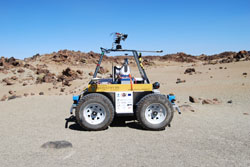Perfecting the robot that could explore space
Humankind has often wondered if weare alone in the Universe and has long hoped to find signs of life on other planets. The quest to find signs of life on other planets is being supported with technology that will includerobotic exploration of the s surface of Mars. The EU-funded project 'Planetary robotics vision scout' (PROVISCOUT) demonstrated the feasibility of scouting for life onother planets. The project brought together experts and scientists from different fields and parts of the world to investigate robotic planetary space missions featuring rovers or aerial vehicles. Specifically, the project looked at imaging data and robotic vision, considering sensor technology, three-dimensional (3D) camera imaging, the power to search for scientific targets and the ability to combine science autonomy with navigation. To achieve its aims the project team addressed novel vision sensor concepts, designed the interfaces between the various components such as rover, vision system, navigation system, decision module and monitoring system. It conducted field tests in Spain and the United Kingdom, integrating sensors and mobility hardware to a fully operational rover and control system for mapping, navigation and science autonomy. Sophisticated sensor technology was able to distinguish between the fluorescence of microorganisms and host minerals, producing high-resolution images that would be crucial in determining if life exists beyond our planet. Work also focused on building an off-board component to monitor rover operations and decisions, as well as developing an aerobot camera on a balloon to capture images. All the components were rigorously tested. Sophisticated testing took place in Mars-like environments such as the Arctic and the caldera of Tenerife in Spain's Canary Islands. Overall, the project team successfully built a framework for on-board, robot-driven vision processing. It developed technology to autonomously select sites of interest during missions and conducted successful field demonstrations. This will help raise public awareness of planetary robotic missions, representing an ambitious EU-led initiative in furthering our quest to explore space.



